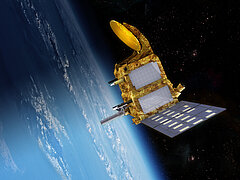News
29.06.2016 14:32 Age: 8 yrs
[Saral] A new phase with a drifting orbit
Category: News of the Saral mission, Operational news
SARAL/AltiKa will leave its repetitive orbit by beginning a new phase named "Saral Drifting Phase", “SARAL-DP” from Monday 4 July. The data processing as well as data latency are unchanged.
SARAL/AltiKa mission will enter in a new phase named “SARAL-DP”. Indeed, from July 4th onwards, SARAL satellite will fly free of station keeping maneuvers; the repetitive ground track will be no more maintained and with the natural decay of the orbit, the ground track will drift. “SARAL-DP” stands for SARAL Drifting Phase.
This decision - endorsed by CNES and ISRO management - is due to the technical issues we have encountered on the reaction wheels since March 2015 and was proposed considering 2 key drivers:
- fine station keeping maneuvers with thrusters only is very difficult to achieve,
- there are new science perspectives emerging with drifting orbits on mean sea surface (MSS), geodesy/ bathymetry and other applications.
and implements two recommendations made by the Science Team in 2015 OSTST meeting which are recalled hereafter :
- RECOMMEND the not-maintained (drifting) orbit for MSS/Gravity/Bathymetry.
- RECOMMEND this phase to start as soon as possible (awaiting 3 years project meeting in early 2016)
CNES and ISRO share the common objective to continue the SARAL mission as long as possible both for altimetry and ARGOS and we hope that the drifting phase will be as successful as the first 3 years on the repetitive orbit. Of course you will be informed on the progress of operational activities.
T. Guinle, J. Verron, P. Bonnefond, S. Arunan





